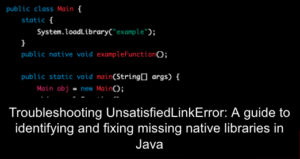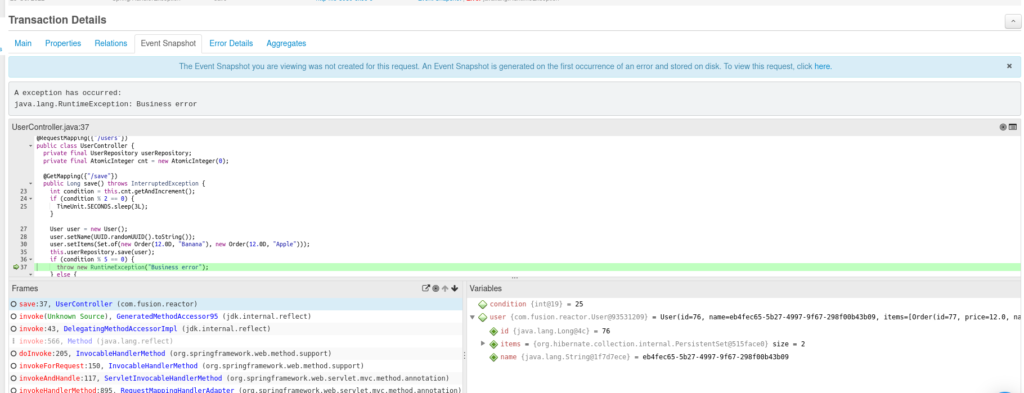The IllegalAccessError is a less common Java exception that is difficult to diagnose without using specialist tools. There are many ways to resolve IllegalAccessError, we will look at the different methods and also include diagnoses using FusionReactor APM. APM tools can provide deep visibility into your application’s performance, enabling you to identify and resolve issues like IllegalAccessError quickly.
In this blog, we’ll discuss the causes of IllegalAccessError and how FusionReactor APM can help you avoid and fix it.
IllegalAccessError is an error thrown in Java when an application attempts to access a class, field, method, or constructor to which it doesn’t have access. This error can cause severe problems in your application, and it’s essential to understand why it occurs and how to avoid and fix it. First, lets look at the error as you may see it in your Java and how it might appear in a stack trace.
here’s an example of the IllegalAccessError exception in code:
public class Main {
public static void main(String[] args) {
try {
Class cls = Class.forName("TestClass");
Object obj = cls.newInstance();
} catch (ClassNotFoundException | InstantiationException | IllegalAccessException e) {
e.printStackTrace();
}
}
}
class TestClass {
private TestClass() {}
}
In this example, we are trying to instantiate an object of the TestClass class using reflection. However, the constructor of TestClass is private, which means it cannot be accessed from outside the class. This results in an IllegalAccessException, caught in the catch block and printed to the console.
The stack trace will look something like this:
java.lang.IllegalAccessException: Class Main can not access a member of class TestClass with modifiers "private" at sun.reflect.Reflection.ensureMemberAccess(Reflection.java:102) at java.lang.Class.newInstance(Class.java:432) at Main.main(Main.java:7)
This stack trace provides information about the location and cause of the error, which can be helpful in diagnosing and resolving the issue.
Causes of IllegalAccessError
- Security Restrictions: Java security restrictions can prevent applications from accessing certain classes, fields, methods, or constructors.
- Missing Required Libraries: If an application requires a library that is not included in the classpath, it can result in IllegalAccessError.
- Incorrect Class Loaders: If different class loaders are used to load classes in your application, they may not have access to the same classes, fields, methods, or constructors, resulting in IllegalAccessError.
How to diagnose an IllegalAccessError
Diagnosing IllegalAccessError without an APM can be challenging, but here are some steps you can follow:
- Review the Stack Trace: The Stack Trace in the error message provides information about the location and cause of the error. This can help you identify the source of the error and determine what classes, fields, methods, or constructors are not accessible.
- Check Security Restrictions: Verify that the application has access to the classes, fields, methods, or constructors it is attempting to access. If security restrictions are preventing access, modify the security policies to allow access.
- Check Classpath: Ensure that all required libraries are included in the classpath. If a required library is missing, add it to the classpath to resolve the error.
- Check Class Loaders: Ensure all classes are loaded using the same class loader. If different class loaders are used, they may not have access to the same classes, fields, methods, or constructors, resulting in IllegalAccessError.
- Debug the Code: Use a debugger to step through the code and identify the exact location where the error occurs.
- Search Online: Search for solutions to similar errors, as others may have encountered and resolved the same issue.
It is important to note that without an APM tool, diagnosing IllegalAccessError can be time-consuming and difficult and may require a deep understanding of the application’s code and configuration.
Using FusionReactor APM to diagnose an IllegalAccessError
- Real-time Monitoring: FusionReactor APM provides real-time monitoring of your application’s performance, allowing you to identify and resolve issues like IllegalAccessError as soon as they occur.
- Code Level Visibility: FusionReactor APM provides code-level visibility into your application’s performance, enabling you to see exactly where the error is occurring and what code is causing it.
- Root Cause Analysis: FusionReactor APM provides detailed root cause analysis, enabling you to quickly determine the underlying cause of the error and resolve it.
- Performance Metrics: FusionReactor APM provides detailed performance metrics, enabling you to monitor your application’s performance over time and identify trends and patterns.
- Monitoring of Library Usage: FusionReactor APM provides monitoring of library usage, enabling you to identify if a required library is missing and resolve the issue before it results in IllegalAccessError.
Fixing IllegalAccessError using FusionReactor APM
- Monitor your application: Use FusionReactor APM to monitor your application’s performance in real-time.
- Identify the error: When encountering an IllegalAccessError, use FusionReactor APM to identify the error and determine the root cause.
- Resolve the error: Once you’ve identified the root cause of the error, use FusionReactor APM to resolve it by fixing the code, updating the library, or modifying the security restrictions.
As soon as an issue occurs, FusionReactor APM allows you to identify and resolve it in real-time
FusionReactors Event SnapShot – Code-level visibility into your application’s performance enables you to identify exactly where errors occur and which code is causing them
Conclusion – Resolving IllegalAccessError in Java: A Guide to Understanding, Avoiding and Fixing
IllegalAccessError is a less common error in Java that can cause severe problems in your application. By using FusionReactor APM, you can avoid and fix this error quickly and effectively, ensuring that your application runs smoothly and performs optimally. So, if you haven’t already, start using FusionReactor APM today and take control of your application’s performance!





